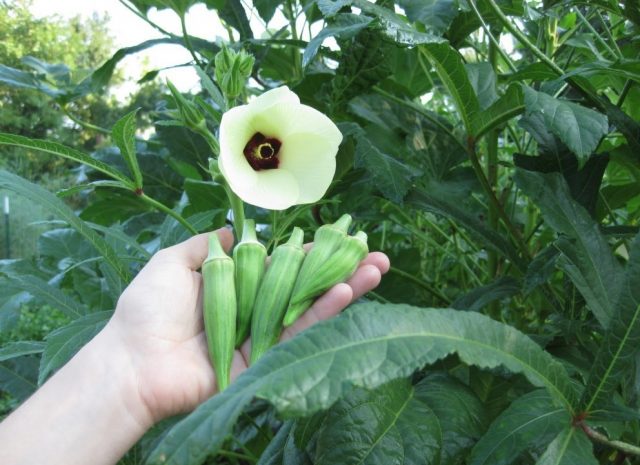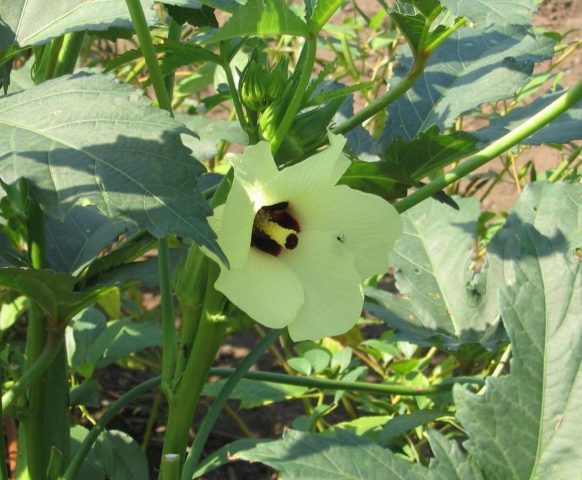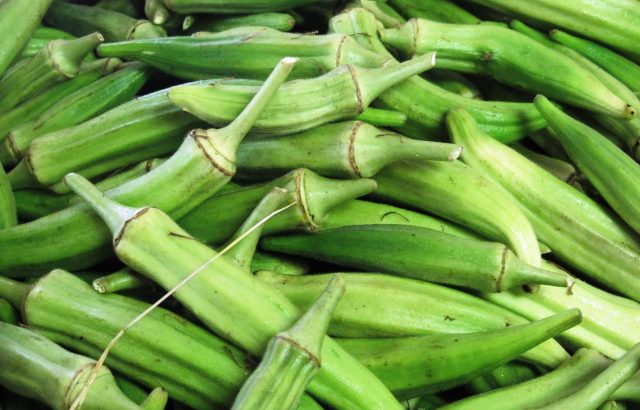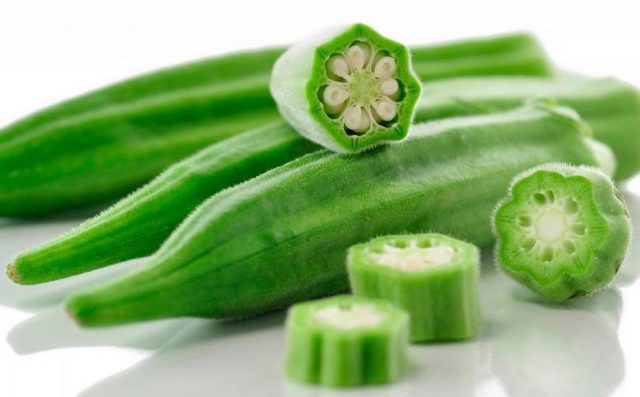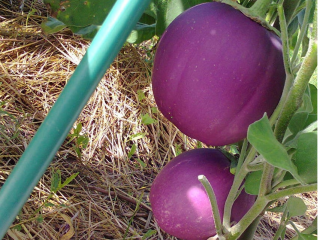Content
The okra plant has many names: it is okra, and abelmos, and delicious hibiscus. Such a variety of names is explained by the fact that for a long time the okru could not correctly classify, mistakenly attributing it to the genus Hibiscus, and only a little later separating it into a separate genus. If we discard all botanical delights, then we can say that okra is a vegetable that has very useful properties and contains a wide variety of vitamins and microelements.
Where does okra grow
The okra plant is of tropical origin: it is found in the wild in North Africa and the Caribbean.
As a domesticated culture, it is widespread on the Mediterranean coast, in particular in southern Europe and the park in Africa. It can be found in both Americas, Central and South Asia.
What does okra look like
Okra belongs to the Malvov family. Having too strong a resemblance to the hibiscus, it is nevertheless a separate species, although it is very easy to confuse the plants. Photo of a typical okra bush:
Externally, okra is a bush (depending on the variety) with a height of 40 cm to 2 m. It consists of a thick and massive stem, 10 to 20 mm thick. Closer to the ground, the stem grows woody. Its entire surface is covered with tough, but rather sparse hairs. Usually the stem, reaching a certain height, begins to branch, and quite abundantly. There are branches up to 7 large shoots.
Okra leaves have thick and long petioles. Their shade can be very diverse, depending on the growing conditions, any gradation of green can be found. The shape of the leaves is five-, rarely seven-lobed. The size of the leaves is from 5 to 15 cm.
The flowers of the plant are located in the leaf axils; they have short pedicels. Okra does not tie inflorescences, flowers are arranged one by one. They are large (up to 12-15 cm in diameter) and have a yellow or cream color. The flowers are bisexual and can be pollinated by the wind.
The fruits of the okra are precisely what determines its isolation from the genus Hibiscus. They cannot be confused with anything because of their characteristic shape. Outwardly, they resemble long pyramidal boxes, similar to pepper fruits. The okra fruit can be covered with fine hairs. The length of the fruit sometimes exceeds 20-25 cm. Below is a photo of the fruit of the okra vegetable:
What does okra taste like?
Okra belongs to vegetable crops due to the fact that its fruits can be eaten, and they resemble typical representatives of this culinary group in consistency and taste.
In taste, okra is a product that resembles both zucchini or squash, and representatives of legumes - beans or beans. This unique property provides okra with a very wide range of culinary uses.
Okra chemical composition
Okra is very rich in nutrients. It contains especially a lot of ascorbic acid (vitamin C). The mucous substances contained in the plant pods are composed of proteins and organic acids, the set of which is very diverse. Fat in the pulp of the fruit contains little.The highest concentration of fat (up to 20%) is observed in the seeds, from which the oil is obtained, which in taste and composition is very reminiscent of olive.
The health benefits and harms of okra are determined by its composition. Raw okra is 90% water. The dry weight of 100 g of the product is distributed as follows:
- dietary fiber - 3.2 g;
- fats -0.1 g;
- proteins - 2 g;
- carbohydrates - 3.8 g;
- ash - 0.7 g.
The composition of the plant's fruits is represented by the following B vitamins:
- Vitamin B1 - 0.2 mg;
- B2 - 60 mcg;
- B4 - 12.3 mg;
- B5 - 250 mcg;
- B6 - 220 mcg;
- B9 - 88 mcg;
- PP - 1 mg.
Other vitamins:
- Vitamin A - 19 mcg;
- Vitamin E - 360 mcg;
- Vitamin K - 53 mcg;
- Vitamin C - 21.1 mg
In addition, the fruit contains about 200 mg of beta-carotene and about 500 mg of lutein. The total content of phytosterols is about 20-25 mg.
The trace element composition of the fruit pulp is as follows:
- potassium - 303 mg;
- calcium - 81 mg;
- magnesium - 58 mg;
- sodium - 9 mg;
- phosphorus - 63 mg;
- iron - 800 mcg;
- manganese - 990 mcg;
- copper - 90 mcg;
- selenium - 0.7 mcg;
- zinc - 600 mcg.
Calorie content of okra
The calorie content of raw okra is 31 kcal.
The nutritional value:
- proteins - 33.0;
- fats - 3.7%;
- carbohydrates - 63.3%.
The plant does not contain alcohols.
Depending on the processing method, the calorie content of okra may vary:
- boiled okra - 22 kcal;
- frozen boiled - 29 kcal;
- frozen boiled with salt - 34 kcal;
- frozen uncooked - 30 kcal.
How is okra useful?
Due to the substances it contains, okra has a very wide range of applications.
First of all, this plant will be useful for pregnant and lactating women, since it contains a sufficient amount of vitamin B9 (folic acid).
Given the low calorie content of the product, okra can be successfully used in various diets and weight loss regimens. And it's not about 20-30 kcal per 100 g of mass, the substances contained in the vegetable contribute to the synthesis of vitamin A and B vitamins, which helps to get rid of depression and fatigue.
Okra is also used for disorders of the digestive system. The mucus contained in its composition, along with dietary fiber, helps to cleanse the intestines, due to the "flushing" of toxins and incompletely digested food residues from it. These substances also contribute to the synthesis of bile and the elimination of cholesterol from the body. Thanks to this complex effect, the state of the intestinal microflora is significantly improved. That is why okra is often recommended for various problems of the digestive tract: dysbiosis, constipation, swelling, etc.
In addition to regulating cholesterol levels, the pulp of okra fruit has the ability to lower blood glucose levels. It is often recommended as a side prophylaxis for patients with diabetes mellitus.
The pectins contained in the pods help cleanse the body due to the removal of heavy metals. Due to the presence of antioxidants and substances that cleanse the body, okra has recently been used for the prevention of cancer.
The seeds of the plant are able to have a tonic effect on the body. Roasted seeds are used to make a tonic drink (like coffee) and are also used to make special oils.
Okra application
Since okra is an edible plant, its main use is in cooking. Considering the listed useful properties of okra, it is also used in medicine, home and professional cosmetology.
In cooking
Okra tastes like a cross between squash and beans, so the easiest way to use it is to replace one of these foods.
Usually, light green pods are used for cooking, which do not have dry blotches.Pods are chosen no more than 10 cm in size, since it is believed that longer ones can be dry.
It is recommended to cook the pods immediately after they have been cut as they quickly deteriorate (become very hard and fibrous).
Okra is used raw, boiled, fried or stewed.
The plant perfectly finds application in various soups, salads, vegetable stews, etc. Okra does not have a pronounced taste, therefore it is compatible with almost all types of products. Temperature conditions for its preparation are similar to those of zucchini.
Okra goes well with various spices - onions, garlic, various peppers, etc. It can be used with butter and vegetable oil, lemon juice, sour cream, etc.
Fried okra pods are perfect as a side dish with any meat or fish dish.
When preparing okra dishes, it is not recommended to use cast iron or copper containers, as the product may change color as a result. The time for extinguishing okra is short - usually it is a few minutes on low heat.
In medicine
Okra promotes the secondary absorption of fluid, removes toxins and excess cholesterol from the body, cleanses it of excess bile. The role of okra in bowel cleansing and normalization of its work is also important.
Also, regular use of okra helps to prevent the appearance of cataracts and diabetes.
An improvement in the composition of blood plasma has also been noted with regular feeding on okra pulp or the use of oil from its seeds.
Scientific research into the pulp of okra fruit confirms that okra can be used against cancer. In particular, it is noted that regular consumption of okra pulp in food leads to a decrease in the likelihood of rectal cancer.
In cosmetology
In cosmetology, okra is mainly used for strengthening hair and treating skin.
It is used in both home and industrial creams and ointments. A hair ointment recipe can be as follows:
- Selected green pods.
- The pods are boiled in water until the broth becomes as slimy as possible.
- The broth is cooled and a few drops of lemon juice are added.
How okra is eaten
Eating okra in food does not have any peculiarities, so it can be consumed like ordinary pumpkin seeds. Despite the fact that it tastes like legumes, okra does not have any unpleasant consequences inherent in them (swelling, gases, etc.).
Contraindications to okra
Like all representatives of the plant world, okra has not only beneficial properties; its constituent components may have contraindications.
The main contraindication is individual intolerance. This phenomenon is quite rare, as the okra pulp or its seeds do not contain any allergens. However, it is impossible to take into account the characteristics of each organism. It is recommended to start with a small dose in the case of the first consumption of the plant for food or as a cosmetics.
Separately, it should be said that the hairs on the okra fruit can cause an allergic reaction, so it is recommended to remove them before any use of the product.
Conclusion
Okra is a vegetable that has many beneficial properties. It can be used in food, replacing many other vegetables, mainly legumes or pumpkin seeds. Okra fruits contain a lot of useful substances and are used to prevent a large number of various diseases.
